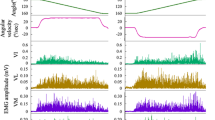Summary
The object of this study was to find out whether an arthrotomy of the knee would damage joint proprioception. Twenty patients who underwent arthrotomy, and 20 patients after arthroscopy, were tested on a modified ergometer and the electromyographic action of their quadriceps and hamstrings recorded. The quadriceps action started later and had a shorter duration (20 ms) after arthrotomy. The differences are statistically significant in intra-individual comparison both for vastus lateralis and medialis, in comparison with the normal group for only the vastus medialis. There were no significant differences in muscle control after arthroscopy. These results are in favour of preferring arthroscopy to arthrotomy whenever possible.
Résumé
Le but de ce travail est de déterminer si une arthrotomie du genou entraîne des troubles de la proprioception. Vingt patients ayant subi une arthrotomie antéroexterne ou antéro-interne, ainsi qu'un groupe de même importance ayant subi une arthroscopie ont été soumis à une épreuve de charge sur une bicyclette ergométrique modifiée; l'activité électromyographique de leur quadriceps et de leur musculature ischio-crurale a été enregistrée. On a pu observer, chez les arthrotomisés, un début d'activité du quadriceps significativement plus tardif et une durée d'activité raccourcie de 20 ms, tant par comparaison avec le côté opposé que par comparaison avec les sujets sains. Les patients traités par arthroscopie n'ont pas montré d'altérations de la commande musculaire. On peut s'attendre à ce que les modifications mises en évidence chez les patients arthrotomisés soient nettement plus marquées en cas d'incisions plus étendues. Ces résultats constituent, à notre avis, un argument de plus pour accorder, dans la mesure du possible, la préférence aux procédés arthroscopiques.
Similar content being viewed by others
References
Barrack RL, Skinner HB, Brunet ME, Haddad RJ Jr (1983) Functional performance of the knee after intraarticular anesthesia. Am J Sports Med 11: 258–261
Clark FJ, Horch KW, Bach SM, Larson GF (1979) Contributions of cutaneous and joint receptors to static knee-position sense in man. J Neurophysiol 42: 877–888
Elmqvist LG, Lorentzon R, Johansson C, Fugl-Meyer AR (1988) Does a torn anterior cruciate ligament lead to change in the central nervous drive of the knee extensors? Eur J Appl Physiol 58: 203–207
Ericson MO (1988) Muscular function during ergometer cycling. Scand J Rehabil Med 20: 35–41
Ericson MO, Nisell R, Arborelius UP, Ekholm J (1985) Muscular activity during ergometer cycling. Scand J Rehabil Med 17: 53–61
Ferrell WR, Baxendale RH, Carnachan C, Hart IK (1985) The influence of joint afferent discharge on locomotion, proprioception and activity in conscious cats. Brain Res 347: 41–48
Gregor RJ, Cavanagh PR, LaFortune M (1985) Knee flexor moments during propulsion in cycling: a creative solution to Lombard's Paradox. J Biomech 18: 307–316
Hanks GA, Gause TM, Sebastianelli WJ, O'Donnell CS, Kalenak A (1991) Repair of peripheral meniscal tears: open versus arthroscopic technique. Arthroscopy 7: 72–77
Haus J, Halata Z (1990) Innervation of the anterior cruciate ligament. Int Orthop 14: 293–296
Johansson H, Sjolander P, Sojka P (1990) Activity in receptor afferents from the anterior cruciate ligament evokes reflex effects on fusimotor neurones. Neurosci Res 8: 54–59
Johansson H, Sjölander P, Sojka P (1991) Receptors in the knee joint ligaments and their role in the biomechanics of the joint. Crit Rev Biomed Eng 18: 341–368
Jorge M, Hull ML (1986) Analysis of EMG measurements during bicycle pedalling. J Biomech 19: 683–694
Lass P, Kaalund S, leFevre S, Arendt-Nielsen L, Sinkjaer T, Simonsen O (1991) Muscle coordination following rupture of the anterior cruciate ligament: electromyographic studies of 14 patients. Acta Orthop Scand 62: 9–14
Lehmann JF, Price R, deLateur BJ, Hinderer S, Traynor C (1989) Spasticity: quantitative measurements as a basis for assessing effectiveness of therapeutic intervention. Arch Phys Med Rehabil 70: 6–15
Lohnert J, Raunest J (1986) Arthroskopische Meniscusresektion und offene Meniscektomie — eine vergleichende Studie. Chirurg 57: 723–727
Skoglund S (1964) Joint receptors and kinaesthesis. Sensory Physiology 11: 111–135
Solomonow M, Baratta R, Zhou BH, et al (1987) The synergistic action of the anterior cruciate ligament and thigh muscles in maintaining joint stability. Am J Sports Med 15: 207–213
Zimny ML (1988) Mechanoreceptors in articular tissues. Am J Anat 182: 16–32
Author information
Authors and Affiliations
Rights and permissions
About this article
Cite this article
Hess, T., Gleitz, M., Hopf, T. et al. Changes in muscular activity after knee arthrotomy and arthroscopy. International Orthopaedics 19, 94–97 (1995). https://doi.org/10.1007/BF00179968
Accepted:
Issue Date:
DOI: https://doi.org/10.1007/BF00179968




